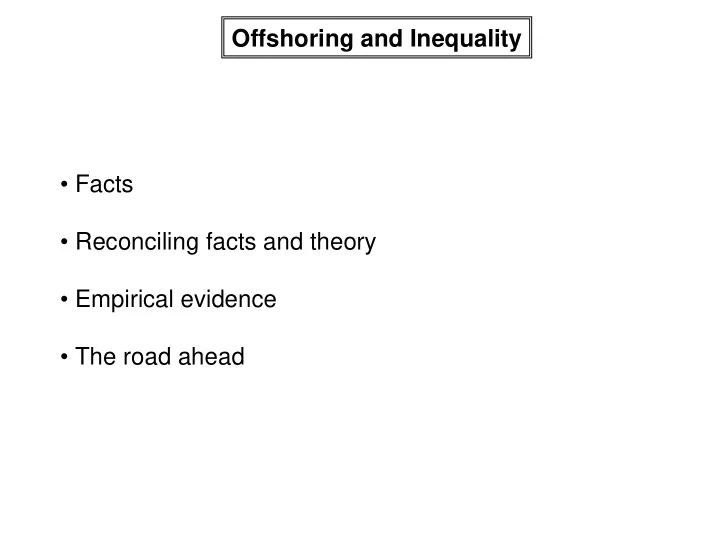

Offshoring and Inequality • Facts • Reconciling facts and theory • Empirical evidence • The road ahead
Offshoring: Facts Offshoring: Fragmentation, slicing the value chain, vertical specialization, outsourcing. Breaking apart the production process with various stages occurring in different countries. Hummels, Ishii and Yi (2001) consider the value of imported inputs embodied in goods that are exported for the 1970-1990 period. The index increased in most countries: From 18% to 24% in France, 20% to 26% in the UK, 6% to 11% in the US. Chen, Kondratowicz and Yi (2005) extends the data to 2000 with similar results. Strauss-Kahn (2004): The index measures the share of imported inputs embodied in production for the 1977–1993 period for France. It increases from 9% to 14%, which represents more than a 50 % growth over the period.
Inequality: Facts Data from the same source for equivalent periods show increase in employment differential (skills correspond to education levels): 83% in Finland, 95% in France, 110% in Norway, 28% in US, 48% in UK. The majority of the increase in inequality occurs within industry (Berman et al. (1994) for the US, Berman, Bound and Machin (1998) for cross-country…)
Reconciling facts and theory Whereas traditional trade theory (HO) fails to capture such observed within-industry change, offshoring provides a trade explanation of the increased inequality. Both offshoring and skilled biased technological change are likely culprit of the increase in inequality. Determining which of these explanations accounts for the observed changes becomes a empirical question.
Empirical evidence Study Country Main Results Offshoring contributes from 15% to 24% of the decline in the share of production workers in the wage bill Feenstra and Hanson (1996, 1997, 2003): U.S. during the 80’s. Offshoring accounts for 11% to 15% of the within- industry shift away from unskilled workers toward skilled workers over the 1977–1985 period and to about Strauss-Kahn (2004) France 25% over the 1985–1993 period. Offshoring to China accounts for about 40% increase of Hsieh and Woo (2005) Hong-Kong the wage share of skilled workers. Offshoring reduces the demand for less-skilled worker Hijzen, Gorg and Hine (2005) U.K. but not for semi-skilled and skilled workers. Offshoring with East Asian countries contributed to skill Yamashita (2008) Japan upgrading in employment.
The road ahead • Firms level data • Include services • Inequality in the 90’s : A different story. Feenstra (2008) reveals that in the 90’s relative wage of skilled to unskilled workers continued increasing while relative employment decreased. Again biased technological change (toward the more skilled) and offshoring are potential explanation. But now we should think in term of offshoring in services. Grossman and Rossi-Hansberg (2008)’s paper provides theoretical evidence.
Recommend
More recommend